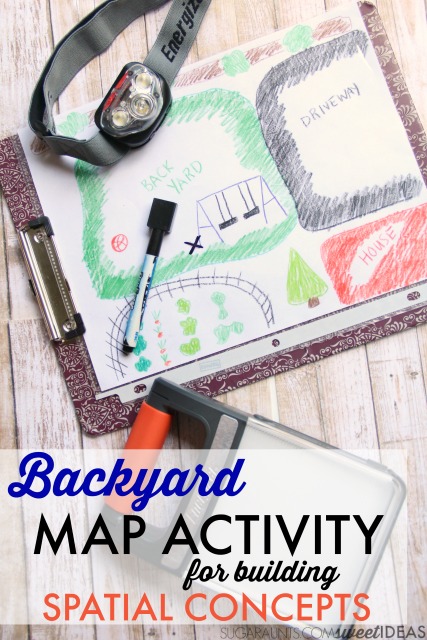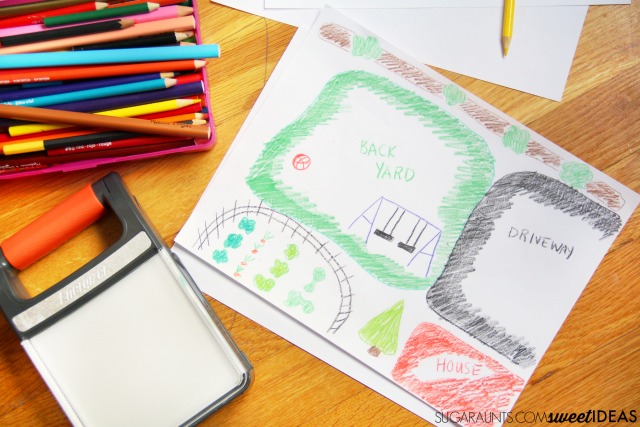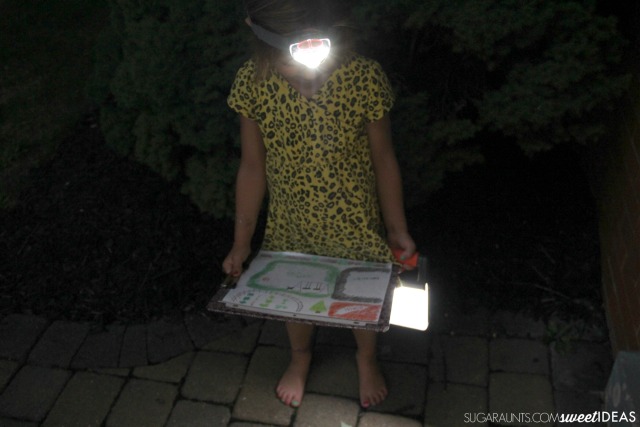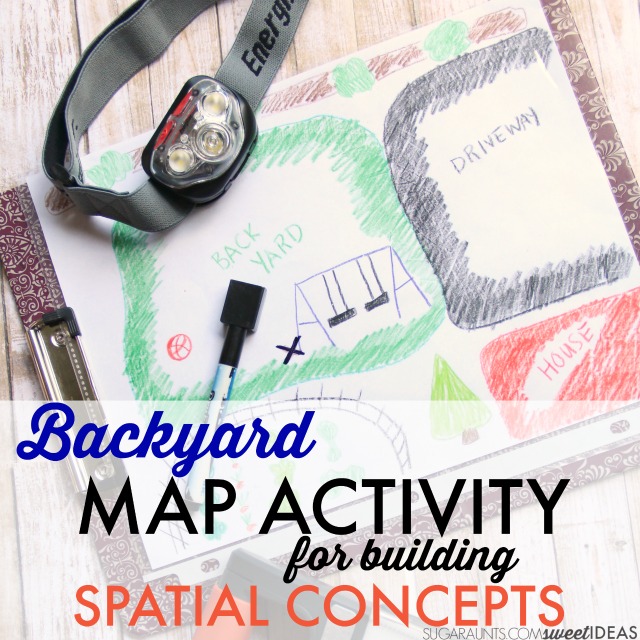This map skills game for spatial concepts uses the ability to integrate spatial relations with what the eyes see with motor skills, or eye-hand coordination. It’s a fun map activity for occupational therapy or play!
Similarly, a drawing mind map incorporates spatial awareness on paper with complex thoughts and ideas, just like using a map as a skill-building game might in real life!
Summertime fun in our house means a lot of nights in the backyard with the family. We catch fireflies, play basketball in the driveway, play baseball on the lawn as the sun sets, have fires in the fire pit, and play heated games of tag, hide-and-go-seek, and make lots of summer memories. Most important of all, summer means time with family.
One thing that we love to do as a family is come up with fun games with a lot of running and active play. This backyard map game for building spatial concepts was a great way to play together as a family at the end of a hot summer day.
When the sun starts to set and the fireflies start twinkling, it is so much fun to create family adventures right in the backyard. We used our Energizer headlight and lantern in a family map game that added a directionality learning opportunity to play.
Map Skills Game
Drawing and creating maps is a great skill for kids to practice. Similarly, the process of using drawing mind maps builds on these visual motor skills, as well.
When kids picture a scene in their mind’s eye and use that image to draw a map on paper, they are using higher thinking skills and directional concepts like over, under, around, and through.

To play an outdoor map game that builds spatial concepts with the family, first ask your kids to picture their backyard.
- Tell them to identify landmarks and borders of the lawn.
- Is there a swing set off to the side?
- Where is the driveway or a large tree and how do these physical features relate to the back of the house?
Imagining a space and where items are in relation to others allow the child to use spatial relations as they draw them onto paper.

While drawing, kids can decide how to draw aspects of the backyard. They might sketch out a tree or a sandbox area or they might use geometric shapes to represent the items.
A circle could become a tree and a square could become a play area. Kids will have to picture the layout of the backyard and draw the features in relation to one another.
Spatial reasoning is an essential skill needed for tasks such as maneuvering down a crowded hallway, placing words on a line when writing, and understanding spatial concepts such as “left”, “right”, and “next to”.
Once the map is drawn, slip it into a plastic page protector and attach it to a clipboard. Grab your headlight, flashlight, or lantern and take the whole family outside to play a map game in the backyard.
Map Game for Building Spatial Concepts
1. To play the game, have one person hide a small toy like a rubber ball somewhere in the backyard.
2. Then, that person can use a dry erase marker to mark an “X” on the sheet protector to show where the item is hidden.
3. The kids can then use the map to locate the item by determining where the object is on the map. Doing this map game in the dark with a headlight or lantern is a great way to build map reading skills and spatial concepts because the child can’t just scan around the lawn to find the hidden object.
4. They must find the “X” on the map and read the map to locate the physical object hidden in the backyard.
5. Take the learning and spatial concepts a little further by asking your child to verbalize where the object is hidden and ask them to use directionality terms like “to the left”, “beside”, and “right”. They can describe the routes they would take to get to the hidden object.

Using the clipboard to follow a map allows the child to focus on where they are going. My kids loved having a headlamp on for our backyard map game because it freed their hands to hold the clipboard, find and hide the hidden ball, and use the dry erase marker to draw an “X” for the other people in our family.
We played this game over and over again so the erasable dry erase marker and sheet protector allowed us to keep playing long after the sun went down!
I loved playing this backyard map game with my kids and we were excited to use our flashlights to play. The versatile lanterns can be used for so many memory-making activities with the whole family.
From filling up a homemade jar with fireflies in a lit area to lighting a S’more making tray, backyard flashlight games can help make the summer nights full of family memories. Add this outdoor activity to your list of backyard lawn games!


Colleen Beck, OTR/L has been an occupational therapist since 2000, working in school-based, hand therapy, outpatient peds, EI, and SNF. Colleen created The OT Toolbox to inspire therapists, teachers, and parents with easy and fun tools to help children thrive. Read her story about going from an OT making $3/hour (after paying for kids’ childcare) to a full-time OT resource creator for millions of readers. Want to collaborate? Send an email to contact@theottoolbox.com.






